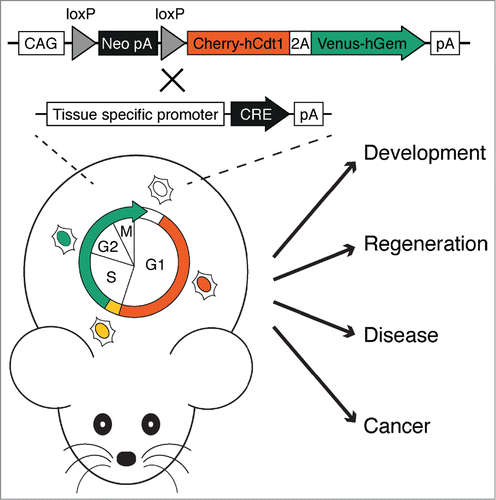Conventional studies of cell cycle often rely on the quantification of cellular DNA content, metabolic labeling of newly synthetized DNA to mark S phase cells, and the detection of cell cycle markers of various nature. However, these are all approaches that do not allow live monitoring of cell cycle progression. This limitation was recently overcome by the development of fluorescent reporter genes which allow the visual discrimination of specific cell cycle phases.Citation1
Prominent among such reporter systems is the Fucci (Fluorescence Ubiquitination-based Cell Cycle Indicator), which relies on the expression of 2 fusion proteins: mAG-hGem(1/110) (a portion of Geminin fused to a fluorescent protein in the green spectrum), and mKO2-hCdt1(30/120) (a portion of Cdt1 fused to a fluorescent protein in the orange/red spectrum). The stability of the resulting fluorescent proteins is regulated by different ubiquitination signals that are recognized by E3 ubiquitin-ligases APC and SCF, which are active respectively in late M/G1 and in S/G2. Therefore, these reporters mark cells in early G1 (non fluorescent), late G1 (red), G1/S (yellow) and S/G2/M phase (green).Citation2
The Fucci system or its more recent version Fucci2 (in which mAG and mKO2 are respectively replaced with mCherry and mVenusCitation3) have been successfully used to monitor cell cycle progression in a variety of cell lines.Citation2,4,5 However, the use of Fucci in vivo, especially in mice, has been limited by the lack of conditional transgene expression, varying (and sometimes very low) expression of the fusion proteins in different tissues, and potential toxicity due to non-physiological level of overexpression.Citation2,6
In issue 13(17) of Cell Cycle, Richard Mort and colleagues report the generation of a novel mouse reporter named Fucci2a, which aims to address the limitations of previous Fucci mice.Citation7 Indeed, the Fucci2a mouse allows Cre-lox mediated conditional expression of a bicistronic transgene targeted to the Rosa26 locus in which the Fucci2 genes are joined by a T2A sequence and driven by the strong and ubiquitous CAG promoter (). This strategy results in a tissue (and potentially time) specific high and homogeneous expression of the Fucci2 reporters in virtually all cell types, while simplifying the maintenance of the mouse line. As proof of principles, the authors show that the Fucci2a mouse can be used to investigate the cell cycle dynamics in the developing lung and kidney. Moreover, they demonstrate the efficacy of the Fucci2a reporter system by monitoring cell cycle in 3T3 cells, mouse embryonic stem cells, and migratory neural crest-derived cells.
Figure 1. Fucci2a mouse and its potential applications. The intercross of the Fucci2a mouse (top allele) with a line expressing the CRE recombinase under a tissue specific promoter (bottom allele) results in CRE-loxP-mediated removal of the Neo-pA cassette and activates the expression of the Fucci2a transgene. This allows to fluorescently mark specific cells according to their cell cycle phase.

The improvements brought by the Fucci2a reporter system are remarkable and could results in a diversity of applications impossible so far. To name but some of the most intriguing, the Fucci2a mouse could be used to identify and isolate small subset of proliferating cells in adult organs where the presence of stem cells is still debatable. Similarly, the Fucci2a also offers the potential to investigate the cell cycle dynamics of stem cells and differentiating progenitors both during embryonic development, organ homeostasis and in tissue repair after injury or infections. Moreover, the Fucci2a mouse could be crossed with genetic models for developmental defects or adult diseases (including cancer), hence allowing one to both investigate the cell cycle dependent mechanisms involved in a diversity of disorders, and screen for potential novel drugs modulating cell proliferation.
Of note, it is important to underline that the Fucci2a system does not solve the limitations intrinsic to the nature of the Fucci fusion proteins. Indeed, overexpression of hGem(1/110) and/or mCheery-hCdt1 (30/120) fusion proteins may be toxic in some tissues. Furthermore, this system does no allow one to discriminate between cells in G1 and G0 (both are labeled red) or cells in S, G2 and M phase (are all labeled green), or to visualize cells in early G1 due to their lack of fluorescence. However, the further development of new cell-cycle reporters in the near future will likely compensate for these drawbacks and the approach shown in the present paper highlights a way forward to use these developments to unlock even more of the potential of the Fucci system.
References
- Kurzawa L, Morris MC. Chembiochem 2010; 11:1037-47; PMID:20397180; http://dx.doi.org/10.1002/cbic.200900729
- Sakaue-Sawano A, et al. Cell 2008; 132:487-98; PMID:18267078; http://dx.doi.org/10.1016/j.cell.2007.12.033
- Sakaue-Sawano A, et al. BMC Cell Biol 2011; 12:2; PMID:21226962; http://dx.doi.org/10.1186/1471-2121-12-2
- Pauklin S, Vallier L. Cell 2013; 155:135-47; PMID:24074866; http://dx.doi.org/10.1016/j.cell.2013.08.031
- Singh AM, et al. Stem cell reports 2013; 1:532-44; PMID:24371808; http://dx.doi.org/10.1016/j.stemcr.2013.10.009
- Abe T, et al. Development 2013; 140:237-46; PMID:23175634; http://dx.doi.org/10.1242/dev.084111
- Mort RL, et al. Cell Cycle 2014;13:2681-96; PMID:25486356; http://dx.doi.org/10.4161/15384101.2015.945381
